Riocreuxia genus
Riocreuxia Genus
Family: Apocynaceae
Common names: R. polyantha : koeiriempies (Afr.); R. torulosa : candle-wine (Eng.); kandelaarblom (Afr.); ugwapha, unquntane, ushuqu (Zulu)
Introduction
Most species in this genus are herbaceous climbers and may cover their supporting vegetation in a green mass of leaves.
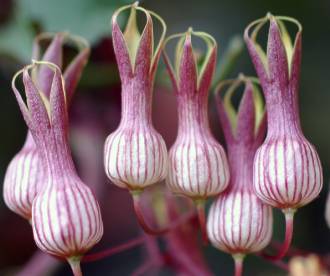
Description
Description
These are perennial herbs with a somewhat woody rootstock, producing a tuft of slightly fleshy or fibrous roots. The stems are annual, twining, climbing or sometimes suberect and tufted, sometimes becoming woody at the base. The leaves are opposite, petiolate, simple, mainly broadly ovate and cordate at base.
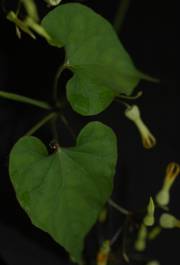
The inflorescences are freely branched. Five sepals are present and the corolla is usually tubular to cylindric in the lower half, which is usually slightly inflated or bell-shaped; the 5 lobes usually form a cage-like tip where the segments are fused in most species. The fruit are terete (cylindrical and tapering) to fusiform (spindle shaped, tapering at both ends) follicles and contain numerous seed. The seeds are winged with an apical tuft of hairs.
Conservation Status
Status
Only a few species of the genus are threatened, but because it is such a small genus, the percentage is high. In South Africa Riocreuxia flanaganii var. alexandrina and R. woodii are Critically Rare; R. flanaganii var. flanaganii is Rare; R. aberrans is Near Threatened and R. torulosa var. bolusii is Data Deficient. The rest of the species are classified as Least Concerned according to the latest threat assessment.
Distribution and habitat
Distribution description
The genus consists of 8 species, 1 in India and the rest in Africa with the main concentration in southern Africa. Species are usually either found in forests and forest-margins or among grassland and scrub. They are usually amongst boulders on rocky ridges. The genus is found from ±sea level to ±2000 m above sea level. Some species are very restricted in distribution and others very widely distributed. All species are restricted to summer-rainfall areas. They do not occur in Namibia.
Derivation of name and historical aspects
History
The genus was described by Decaisne in 1844 based on R. torulosa which was included in Ceropegia L. by Meyer in 1837. The genus was named in honour of Alfred Riocreux (1820-1912), a French botanical artist who made a good drawing of the plant from herbarium material.
In Riocreuxia the corolla is cage-like as in Ceropegia and therefore it was originally classified as a section of the latter genus by Huber in 1957. This character is attributed to parallel development and other features suggest that it is probably rather related to the tribe Marsdenieae.
Ecology
Ecology
Specialized pollinators pollinate the tubular flowers. The seed are wind distributed and are specially equipped with a tuft of hair that folds open when the seeds are released from the fruit (follicle). This ensures that they are carried away by the slightest breeze.
Uses
Use
The only reference to these plants being used is for food is to the leaves being cooked as spinach. It has been reported that the eating of this may lead to severe headaches in some people.

Growing Riocreuxia genus
Grow
Potted or in a shady garden these may be well worth cultivation, especially for the specialist. Although plants die back almost entirely in winter in areas where they are prone to frost, some species may become quite robust and may smother their supporting vegetation.
The flowers are quite attractive and some of the larger-flowered species may well prove to be worthy of cultivation. Personally the author has never found any of these species for sale in nurseries.
Species
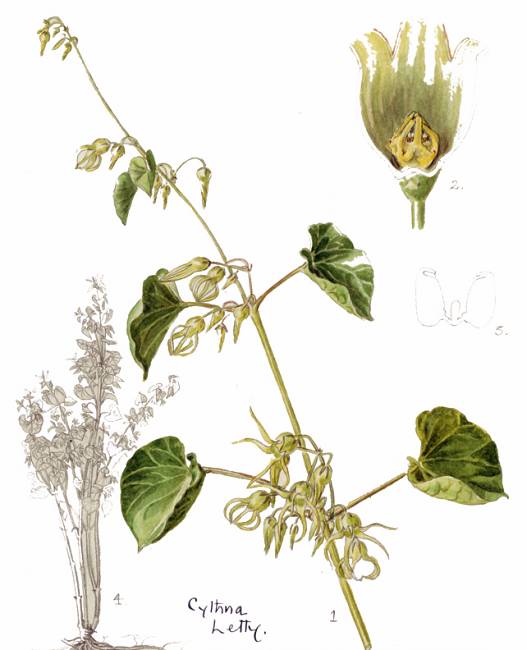
Riocreuxia aberrans: the relatively short campanulate corolla-tube and usually free lobes makes this species readily identifiable. Restricted to quartzite ridges in the Ermelo and Belfast districts of Mpumalanga. It has a large attractive flowers and is the only species that tends to rather form a bush than being a climber. Flowers mainly in November to January at altitude 1900–2100 m.
Left: Illustration of Riocreuxia aberrans
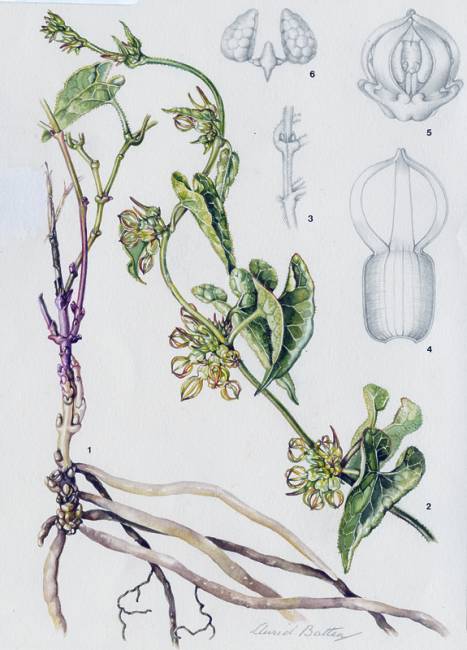
Riocreuxia flanaganii var. alexandrina : endemic to southern KwaZulu-Natal with a very restricted distribution. The inflorescences consist of 5 small flowers 10–15 mm long. The species was named after the region where it was first collected inland from Port Shepstone in KwaZulu-Natal. Usually found twining amongst grasses and in forest precursor scrub.
Left: Illustration of Riocreuxia flanaganii

Riocreuxia flanaganii var. flanaganii : was named after H.G. Flanagan, a farmer from the Eastern Cape, who made numerous collections and had a strong interest in Botany. This species is frequently found in grassland among boulders on the coast becoming twining inland amongst tall grass and low shrubs in open veld. It is found from East London and Komga to the southern Transkei coast and flowers from November to February at altitude 30–300 m.
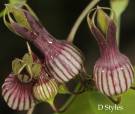
Riocreuxia picta: Found in Limpopo, Mpumalanga, Swaziland, KwaZulu-Natal and Lesotho. This species is readily distinguished by the longitudinal, purple, brown or purple-brown veins on the corolla, the feature from which the name was derived. The corolla lobes taper to a very slender tip in bud. Flowers January to April. Grows naturally on forest margins from 900–1800 m.
Riocreuxia polyantha : was named after the famous William Burchell, a naturalist and explorer of the Cape in 1810-1814. It is also a widespread species from Limpopo, Mpumalanga, Gauteng, Northwest, Northern Cape, Free State, Lesotho, KwaZulu-Natal and rarer in KwaZulu-Natal and the Eastern Cape Provinces. It is distinguished from the closely related R. torulosa by not being as hairy and by the absence of the basal bulge of the corolla. Flower December to May. Naturally found on forest margins (montane and riverine forests), wooded savannas and thickets. Altitude 0–1800 m.

Riocreuxia torulosa var. bolusii : the variety was named in honour of Henry Bolus, after whom the Bolus Herbarium at the University of Cape Town was named. The single plant from which the species was described was collected by Bolus on the banks of the Umtata River in the Eastern Cape. It is suspected to be of hybrid origin as it occurs in the distribution range of both the typical R. torulosa and R. burchellii but has never again been collected. Flowers mainly in February.
Riocreuxia torulosa var. torulosa: is characterised by its distinctly bulged basal part of the corolla. It is widespread from Limpopo, Gauteng, Free State, Lesotho, Swaziland, KwaZulu-Natal, Eastern- and Western Cape. Mainly climbing in forest margins. Torulosus means to be cylindrical with constrictions at regular intervals and refer to the bead-like fruit of this species. Flowers October to April. Known to be eaten as a vegetable (spinach or infimo)
Riocreuxia woodii : named after Medley Wood, the founder of the KwaZulu-Natal herbarium and known from a single location at Inanda in KwaZulu-Natal where almost all of the natural vegetation has been transformed. It is closely related to R. flanaganii from which it is distinguished by its 25-80 mm long peduncles with clusters of 8-25 flowers and in having different distributions. Flowers in June.
References
- Dyer, R.A. 1951. Riocreuxia polyantha. The Flowering Plants of Africa 29: t.1124.
- Dyer, R.A. 1957. Riocreuxia abberans. The Flowering Plants of Africa 32: t.1253.
- Dyer, R.A. 1980. Riocreuxia In Leistner, O.A. (ed) Flora of southern Africa Vol. 27(4): 83âe"88.
- Dyer, R.A. 1983. Ceropegia, Brachystelma and Riocreuxia in southern Africa. A.A. Balkema, Rotterdam.
- Leistner, O.A. (ed.). 2000. Seeds plants of southern Africa : families and genera. Strelitzia 10. National Botanical Institute, Pretoria.
- Masinde, P.S. 2005. A revision of the African genus Riocreuxia Decne. (Apocynaceae: Asclepiadoideae-Ceropegieae). Kew Bulletin 60: 401âe"434.
- Nicholas, A. 1989. Riocreuxia flanaganii. Flowering Plants of Africa 50: t.1991.
- Pooley, E. 2005. A Fieldguide to Wild Flowers: KwaZulu-Natal and Eastern Region. The Flora Publication Trust, Durban.
- Smith, C.A. 1966. Common names of South African plants. Memoirs of the Botanical Survey of South Africa No. 35.
- Styles, D. & McDonald, G. 2009. New provincial records for KwaZulu-Natal : Riocreuxia flanaganii and Gnidia racemosa. PlantLife 37 & 38: 56âe"63.
Credits
S.P. Bester
National Herbarium
November 2010
Plant Attributes:
Plant Type:
SA Distribution:
Soil type:
Flowering season:
PH:
Flower colour:
Aspect:
Gardening skill:
Special Features:
Horticultural zones






Rate this article
Article well written and informative
Rate this plant
Is this an interesting plant?
Login to add your Comment
Back to topNot registered yet? Click here to register.